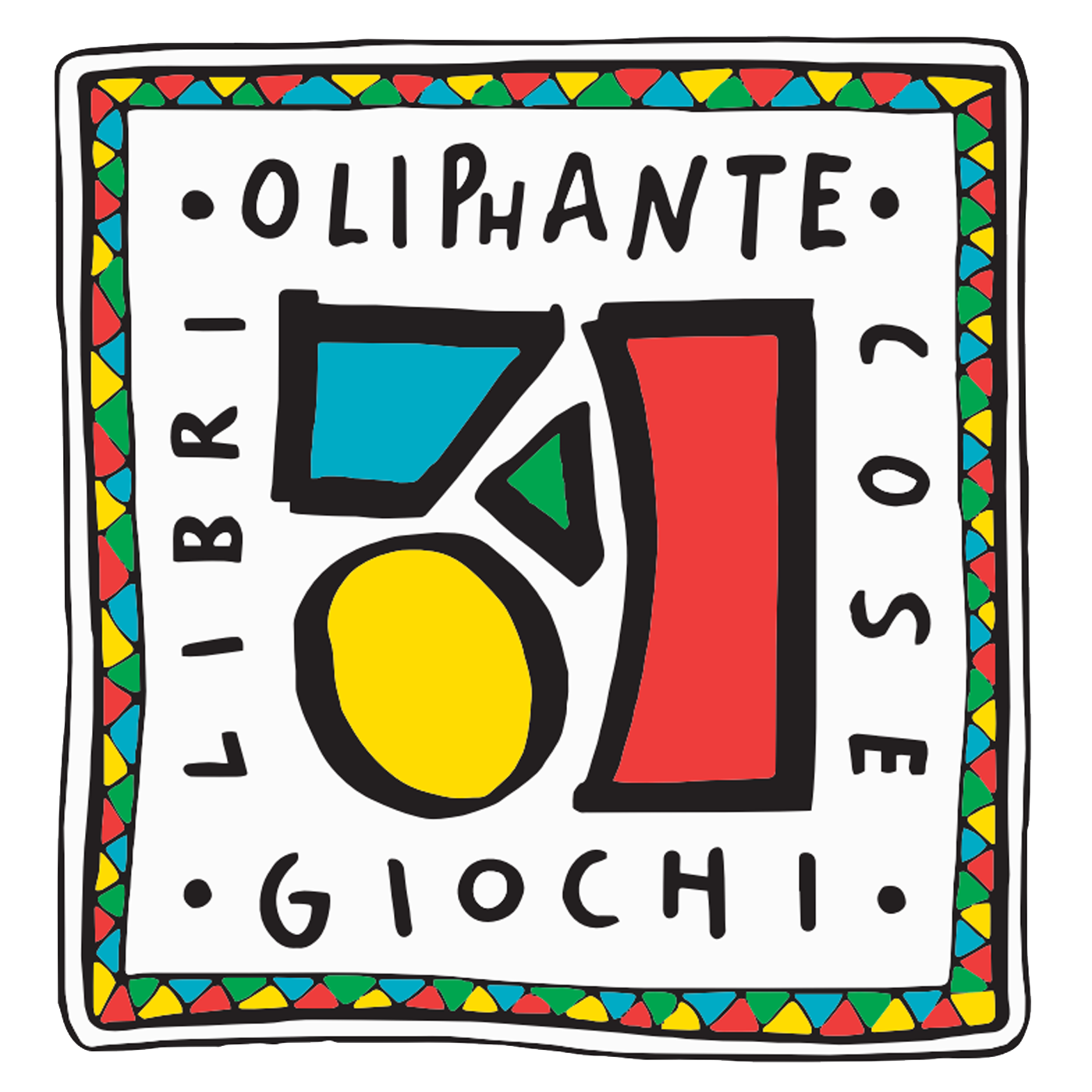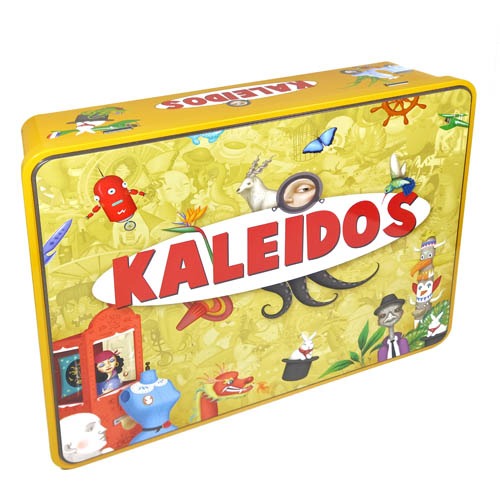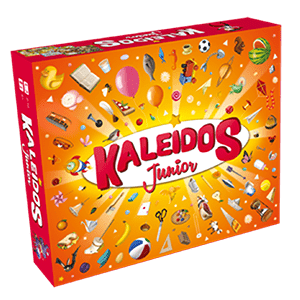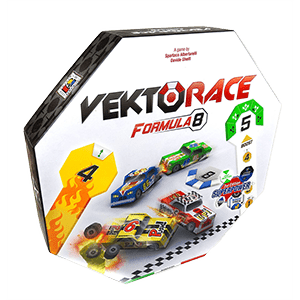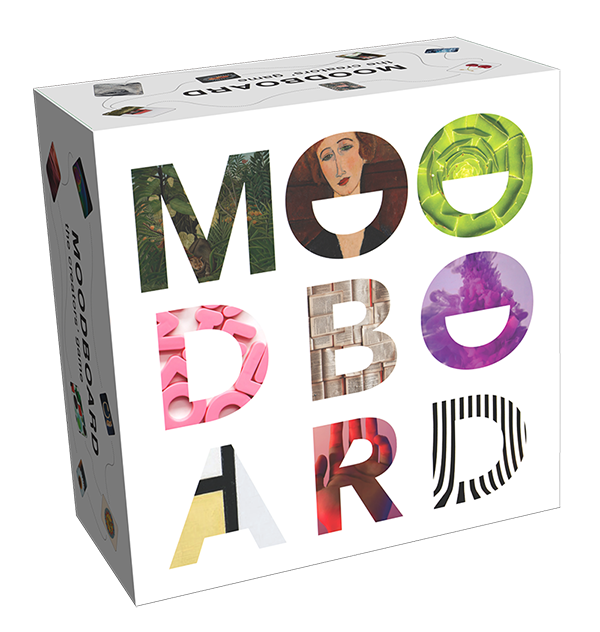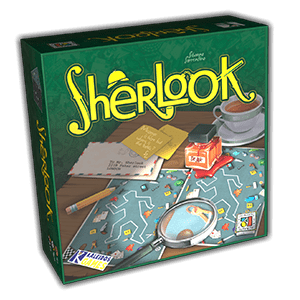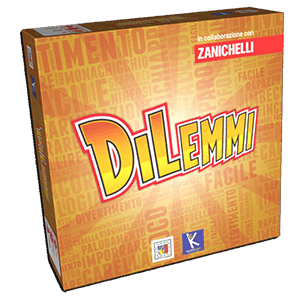Clicktown no longer has guns, but duels persist to find the ‘Fastest Brain in the West’. Create winning patterns and complete the most valuable combinations to earn more money than your opponents!
55 cards:
40 Pattern cards
7 Challenge cards
7 Targets/Bank cards
35 coins
1 “Clementine” card
Earn more dollars than your opponents.

Sort out the 7 Targets/Bank cards and the “Clementine” card from the rest.
Deal a Targets/Bank card to each player who will keep it in front of them, with the Target side visible, and place the “Clementine” card on the table, within reach of all players.
Shuffle the remaining cards (Pattern + Challenge) and create a Wheel of 8 face up cards on the table. If there are any Challenge cards among the cards that compose it, they must be discarded and replaced with other cards drawn from the deck until you get a Wheel without any Challenge cards.
The remaining cards must be placed in the center of the Wheel to form the Center Deck.

You’re ready to play!
A pattern is a specific sequence of cards that repeats within the Wheel.
The Wheel is like a clock, it has a “before” (counterclockwise) and an “after” (clockwise), essential for the declaration of patterns.
A pattern is made by covering one of the cards in the Wheel with one of your own Pattern cards.
For the purposes of the game, a pattern must always be a new one. That is, you cannot create a pattern already existing, playing your card.
A pattern can repeat once, twice or more, involving a variable number of cards.

Players can create a pattern based solely on the following Pattern card characteristics:
COLOR (Red, Blue, Yellow, Grey and White)
SUIT (Coin and Bullets)
OBJECT (Gun, Loot, Star, Bottle, Horseshoe, Dynamite, Barrel and Poster “Wanted”)
The pattern must ALWAYS contain an OBJECT paired with one of the other two characteristics (COLOR or SUIT) and the cards must always be immediately consecutive with each other.
In the images, two examples of patterns:
1) “After every blue card, there is always a following card showing a Bottle”
The pattern is valid because it contains an object, in this case the Bottle.
The sequence is recurrent (it happens at least twice) and the statement, true and incontrovertible, can therefore be simplified into: “AFTER every Blue there is ALWAYS a Bottle”

2) “Immediately before a card showing a Bullets Suit, there is a “Wanted poster” card.”
The pattern is valid because it contains the characteristic object, in this case the “Wanted poster”.
The sequence is recurrent (it happens at least twice) and the statement, true and incontrovertible, can therefore be simplified into: “BEFORE Bullets there is ALWAYS a Wanted”

Note: a valid pattern is always the affirmation of something existing. “After a Bottle there is never a red card”, for the purposes of the game, is not a valid pattern.
Now that you know how to create a pattern, you are ready to hit the Wheel to win cards and realize your winning combinations.
At the beginning of each round, players draw a card from the Center Deck without looking at it. When everyone is ready, players simultaneously look at their own card and the “shootout” begins.
The first player to cover a Wheel card ends the turn and must declare the valid pattern they have created.
A valid pattern can be composed of Object + Suit or Object + Color and can be repeated once or more, thus giving rise to different game situations.
It is repeated only once: the player wins the card covered to make
the pattern.
Archibald plays the YELLOW-STAR-COIN card and declares: “Immediately BEFORE every STAR card, there is always a COIN card.”
The pattern is valid and repeats only once. Archibald wins the card he covered (i.e., the card underneath the one he played).

It is repeated twice or more: the player wins the card covered and
the card player.
Martha Jane plays the WHITE-STAR-BULLETS card and declares: “Immediately BEFORE every STAR card, there is always a COIN card.”
The pattern is valid and repeats twice.Martha Jane wins both the card she covered and the card she played.

It is repeated only once: the player wins any card of their choice among those in the Wheel (but not the one they played).
Phineas plays the BLUE-GUN-BULLETS card and declares:
“Immediately BEFORE every LOOT card, there is always a BLUE card.”
The pattern is valid and repeats only once. Phineas wins any card of his choice from those in the Wheel (but not the one he played).

It is repeated twice or more: the player wins any two cards of their choice among those in the Wheel.
Dakota plays the YELLOW-LOOT-BULLETS card and declares:
“Immediately AFTER every BLUE card, there is always a LOOT card.”
Dakota wins wins two cards of her choice, including the one she played if she wishes.

When ALL 8 cards of the Wheel are involved in the pattern (independently if based on OBJECT and SUIT or OBJECT and COLOR) the rare “Wild Wild Pattern” has been created! That determines an instant victory for the talented player who got it.
“Immediately AFTER every BLUE card, there is always a LOOT card.”
The pattern involves 8 cards: WILD WILD PATTERN!

If a player declares a pattern that does not respect the rules, the card played is discarded and all the opponents win any one card of the Wheel of their choice (starting from the player to the right of the person who made the mistake and continuing counterclockwise).

At the end of the game round, every player who still has cards (clockwise to the player who has just finished the game round) places their cards on the Wheel with the following priorities:
1. If there is an empty space, they fill it (if more than one, choose freely).
2. If there are no empty spaces, they cover any card of the same color.
3. If there are no empty spaces and there are no color matching cards, they can choose freely.
4. If players do not have enough cards to fill all the empty spaces, draw from the Central Deck.
If you understand (or suspect…) that your card is not useful to create a valid pattern you can start a show down saying “Click!” and putting your card, clearly visible to everyone, on top of the Center Deck.
Your opponents have the time of you singing “Oh my Darling Clementine” to find a valid pattern using your card (now you know what the card with the lyrics is for, but don’t worry, if you don’t know the song, or if you are shy, you can always limit yourself to count up to 10…).
Click on image to enlarge
• If none of the opponents manage to create a valid pattern by the end of your performance, you win a card chosen from the 8 in the Wheel (the card on top of the Center Deck is discarded).
• If one of the opponents manages to create a valid pattern with your card, they will win one or two cards according to the usual reward for creating a valid pattern.
When the round is resolved, all players with a card still in hand place it on the Wheel according to the order and priority described above.
Challenge cards offer strategic advantages without directly contributing to pattern formation.
When a player discovers that he has drawn a Challenge card they must place it in front of them and draw another one with which they can try to make a valid pattern (while others are already thinking…).
Winning any game round activates the Challenge card, which can be used to collect the associated prize or take advantage of its effects.
A player may have multiple Challenge cards, possibly found in different rounds, but these can only be activated individually, that is, one per turn won.
Challenge cards are discarded after use.

1 Card: Steal any face up card on the table.

Do not shoot the piano player: Discard an opponent’s Bullets Suit card.

Hands up!: Discard an opponent’s Coin Suit card.

Trade a card with
an opponent:
You can trade any of your cards face up for any of an opponent’s cards (including Challenge cards).

1$: Get 1 dollar from the Bank
50¢: Get 50 cents from the Bank
10¢: Get 10 cents from the Bank
I turni di gioco si susseguono fino a quando almeno un giocatore ha conquistato almeno 5 carte, decretando così il termine della manche in corso.
Se, prima che un giocatore conquisti la quinta carta, il Mazzo Centrale si esaurisce, o le carte risultano insufficienti per il turno successivo, le carte della Ruota e quelle precedentemente uscite dal gioco vengono unite in un nuovo mazzo e mischiate. Un nuovo setup consentirà di proseguire.
At the end of the game, players go to the Bank and scroll from top to bottom the Bank card to check the combinations made and the targets won, demanding the relative prizes.
But how does the Bank pay?
Like all banks, the Bank of Clicktown does not release money so easily… it only pays for precise combinations! For example “1 of a Suit” is paid only if you have exactly one card of a Suit (Bullet or Coin). If you have more than one, the Bank will not release a single cent for this combination!
Similarly, the combination “3 same Color” will only be paid if you own exactly three cards of the same color (not four or five)…
Click on image to enlarge
That is, all combos listed on the Bank card are to be understood “exactly” and not “at least”.
By the same scrupulous principle, who should show up at the Bank having won more than 5 cards in the just ended round, will be kindly accompanied to the door… empty-handed…
Conversely, if a player shows up at the Bank proudly displaying a “Wild” combination they are immediately proclaimed as the new Managing Director of the Bank, winning the game.
Once the deserved earnings are collected (and if no one has reached a victory condition), the game goes on with a new setup (new Wheel, new Center Deck and new Target cards ).
Wild Wild Pattern can be played in two modes:
• Saloon! (for a fistful of dollars) 2 to 4 players
• Dead or alive!
The player who, following a payment from the Bank, exceeds (or exceeds with greater margin) the dizzying sum of 3 dollars is the winner.
Progressive elimination:
Ok Corral (4 players)
Mexican Stall (3 players),
High Noon (2 players)
At the end of each round, the player who, after having cashed from the Bank, has less money is eliminated; the earnings of the remaining players are reset and a new round begins with the game set-up.
If at the end of a round more than one player has the lowest score the elimination is multiple.
The player who eliminates all opponents wins.







